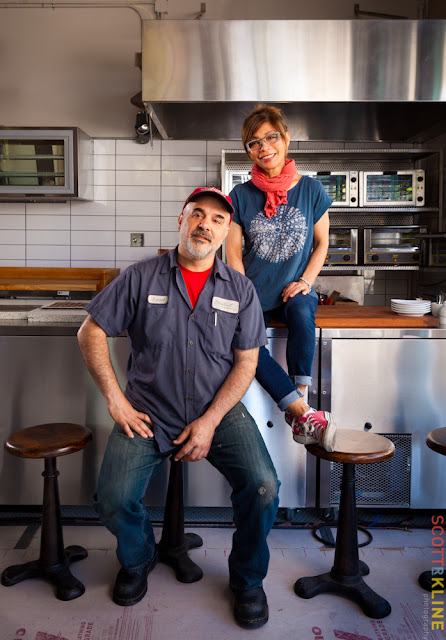 |
| Jenn Lyons with Pete and Siggie photographed in Dogpatch near Espirit Park. |
Even the tag line of Lyons' dog walking business sets the tone: Josi's Paw -- for friendly pets and people.
Josi's Paw is more than just a dog walking and pet sitting service though -- Lyons offers peace of mind to dog owners (sorry, caretakers) -- a reassurance that their faithful companion will not only be well exercised and cared for by Lyons, but also that Lyons will treat their dog as one of her own.
Lyons granted us an interview during a rare break in her schedule. With her two dogs Pete and Siggie (age 6) by her side, we got to know more about this Dogpatch dog walker.
 |
| Jenn takes her charges on a walk through Dogpatch. |
I guess it started with my love for a dog -- Josephine -- or as I called her, Josi. She died in 2006. She was my first dog as an adult and she was just the best dog. She made non-dog lovers into dog people. I made friends because she was so sweet and affectionate to everyone. She was my role model on how to be with people and with animals.
I didn't really consider this as a profession until I moved from the Midwest to San Francisco in 2007. I actually worked in a retail pet shop when I moved here. I felt like I was searching for my next career after spending time in advertising and in the fashion industry. I knew I wasn't a desk job type person -- I need to be moving to feel happy. And I love being outside.
So I started Josi's Paw in honor of Josephine in 2008. It was one way for me to honor and memorialize her
 And I love what I do. I treat each client's dog as if the dog were my dog. Even if they are complicated dogs! I'm their caretaker. That is important to my clients but equally important is that I keep their dog safe. All dogs are always on a leash.
And I love what I do. I treat each client's dog as if the dog were my dog. Even if they are complicated dogs! I'm their caretaker. That is important to my clients but equally important is that I keep their dog safe. All dogs are always on a leash.I'm also deeply aware that a client trusts me to enter their home and to take care of their loved one. So it is important to me that I'm the one actually taking care of the dog and being in their home. I also leave notes for each client describing how their dog did. I think it gives the client an extra bit of reassurance to hear about their dog's day!
I also love to bring my clients together with their pets several times each year for dog parties! I actually have an event coming up Sunday, October 28 -- a Halloween dog party at Pawtrero Pet Shop. These parties are a lot of fun and are a good way to meet new people -- many of my clients have become my personal friends.
I grew up in the Midwest and my relatives still can't believe that dog walking is an actual profession!
Why Dogpatch?
Most of my clients are in Dogpatch or Potrero Hill. I love how it is off the beaten path a bit and therefore not overly busy. And because it isn't as busy as other SF neighborhoods, it is a safer place to walk dogs.
My husband and I love the neighborhood so much we actually just bought a condo here. And of course I love the name of the neighborhood!
 |
| Jenn gets a great view from 18th street toward the Bay. |
 |
| It takes lots of keys. |
What is an interesting story that has happened to you in Dogpatch?
I was talking to Ian, one of the owners of Mr. and Mrs. Miscellaneous ice cream shop, and I admired his tattoos. He referred me to the tattoo artist that he had used. For my birthday I had an image of a hummingbird together with the Mandarin symbol for dog tattooed on my wrist.
A hummingbird is my animal totem -- I'm inspired by their sweetness for life and how they live in the moment. I love how I can see the tattoo on my wrist as I walk the dogs.
What would you be doing if you weren't doing this?
If I weren't doing this it would still have to involve dogs in some way! Perhaps a dog friendly wine bar since I love wine and food!
 |
| Jenn's dogs are not shy for the camera. |
 |
| Linus says hello to start his walk. |
 |
| Jenn shows an imprint of Josie's paw and her hummingbird tattoo. |
Article written by Patricia Kline
Photographs by Scott R. Kline




































